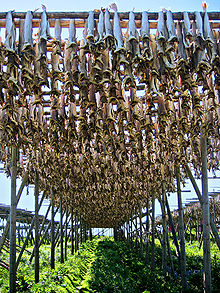Drying
Drying is a mass transfer process consisting of the removal of water or another solvent[1] by evaporation from a solid, semi-solid or liquid.
In the most common case, a gas stream, e.g., air, applies the heat by convection and carries away the vapor as humidity.
Another indirect technique is drum drying (used, for instance, for manufacturing potato flakes), where a heated surface is used to provide the energy, and aspirators draw the vapor outside the room.
For example, evaporation of solvent from a solution containing helical polymer results in a highly ordered array of squashed toroidal structures.
Concerning dried fruits, the reduction of moisture acts in combination with its acid and sugar contents to provide protection against microbial growth.
Products such as milk powder must be dried to very low moisture contents in order to ensure flowability and avoid caking.
Among non-food products, some of those that require considerable drying are wood (as part of timber processing), paper, flax, and washing powder.


